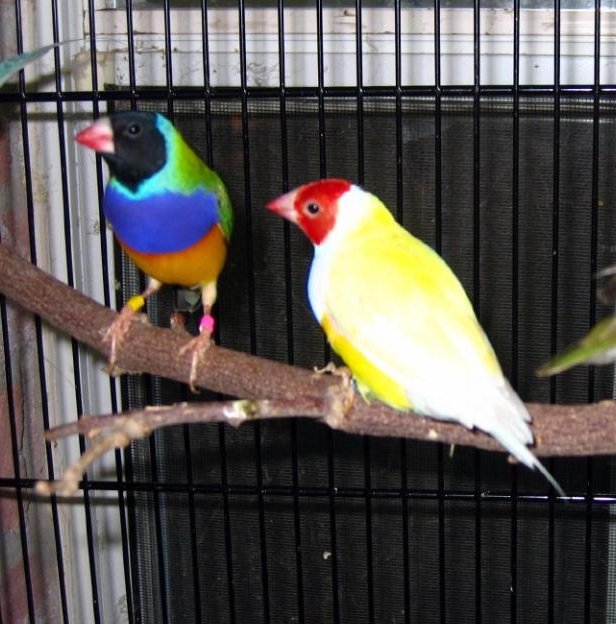
Gouldians:
These are small colorful finches from Australia. They are easily mixed with other peaceful birds, but do have a tendency to stress easily, so when mixing with high energy finches like parrot finches, zebras, etc., they will need to be in larger flight cages.
Gouldians require higher protein intake during molting and breeding via egg food and chitted seeds. Their life cycle is dependent on cycling their nutritional intake as well as to a lesser degree dependent on temperature and humidity.
They are more prone to stress and infection than many of the other finches I keep. Treatment for air sac mites and having a broad spectrum antibiotic to treat as soon as there is sign of illness can save lives. Reducing causes of stress - sudden temperature changes, poor nutrition, over crowding, etc. will help to keep them healthy as well.
They breed very well per pair in individual breeder cages of at least 24"x18"x18", prefering 30" cages.
There are a lot of mutations for gouldians, which is why it is so fun to breed them. White/lilac breast and the yellow mutation have been very established and are just as strong as normal individuals. The blue mutation is a somewhat newer mutation. While there are many breeders who produce very robust blue/silver birds and report them being just as strong as normals and yellows, from my experience, the blue/silver birds tend to be more susceptible to cold temperatures, drafts, as well as infection compared to normals/yellows. Blue/silver juveniles seem to require a lot more warmths to get through their weaning and juvenile molt successfully.
Main note on breeding is to avoid breeding blue/silver birds to blue/silver birds; instead, breeding them to split to blue birds will produce healthier individuals.
Links for Gouldians:
1. http://www.ladygouldian.com/
2. http://www.ladygouldianfinch.com/
3. http://www.glamgouldians.com/index.php
4. http://www.finchinfo.com/birds/finches/species/lady_gouldian_finch.php
5. http://www.fabulousfinch.com/
6. http://www.mfgouldianfinches.com/index.html
7. http://www.friskyfinches.com/index.htm
8. http://users.skynet.be/fa398872/navfram.en.htm
*********************************************************************************************************************
Star Finch:
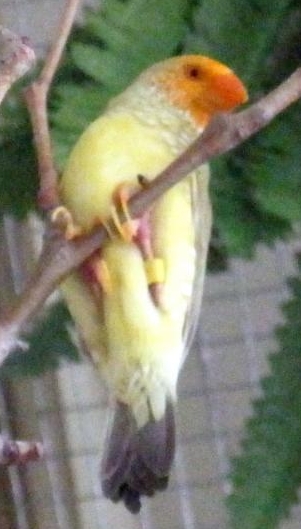
These are beautiful and charming finches from Australia. They are easily mixed with other peaceful birds. They are slightly smaller in bulk compared to gouldians and are a little flightier.
There are some very interesting mutations available. Most common is the yellow faced star. There are also dilute aka isabel aka pastel aka fawn, cinnamon, and pied which can have red or yellow faces. Combination of fawn and cinnamon reportedly gives a yellow bodied bird. Here in the USA, I've seen yellow face, fawn, and pied stars. I have not seen any I recognized as cinnamon or yellow. There is also supposedly a blue mutation for stars, but I have not even been able to find a picture of such a bird.
Breeding can be done in breeder cages by individual pairs. I've gotten better results by putting them into large flight cages, but I have a friend who breeds them very successfully in smaller breeder cages. Since they are a little flighty, it will help a lot to give plenty of privacy and cover with fake plants.
My stars will eat mealworms because they are in flights with waxbills, but they do not require live food to breed. Fresh homemade eggfood will be sufficient.
Links for Star Finch:
1. http://www.finchinfo.com/birds/finches/species/star_finch.php
2. http://www.lonchura.com/articulos/mutaciones_ruficauda_2/mutaciones_ruficauda2_en.html
3. http://www.aussiefinchbreeder.com/Star%20finch.wps.htm
*********************************************************************************************************************
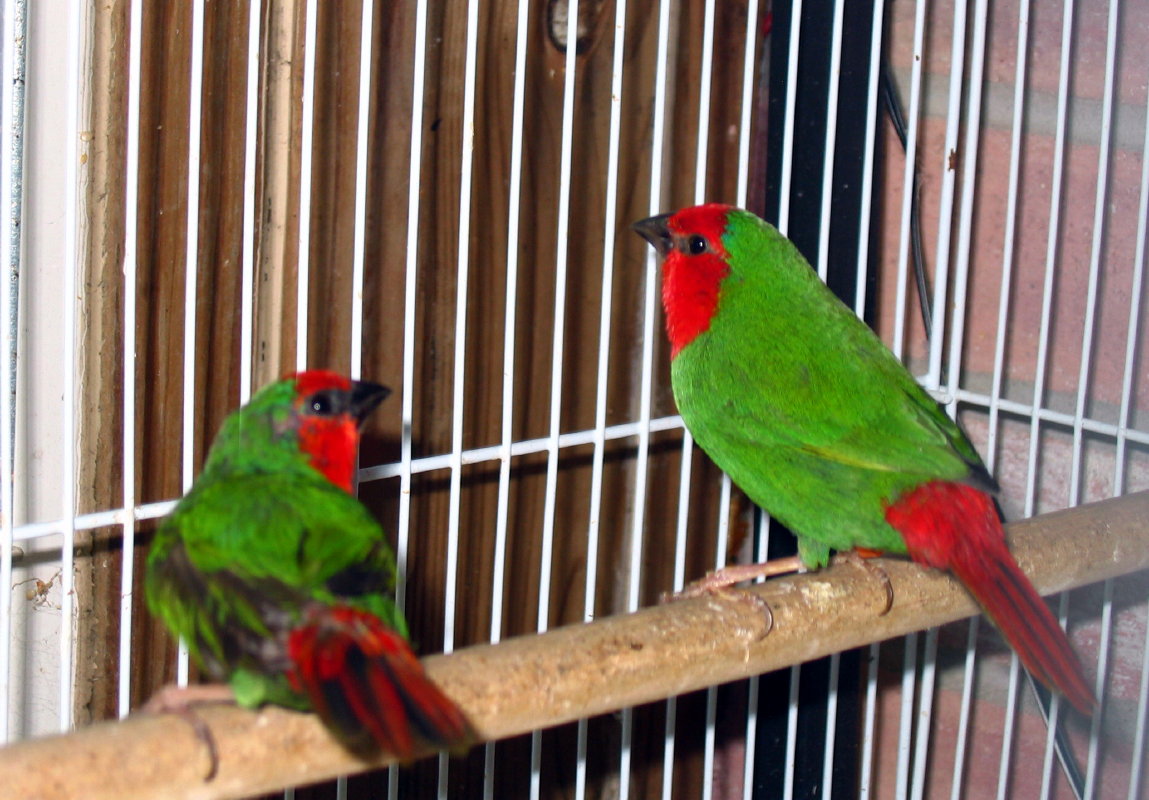
Parrot Finches:
These are a variety of colorful and lively small birds from tropical forests. They are easily mixed with other peaceful birds, but because they are very energetic, they do better in larger flight cages or aviaries. They can get a little territorial during breeding, so again, plenty of space is best.
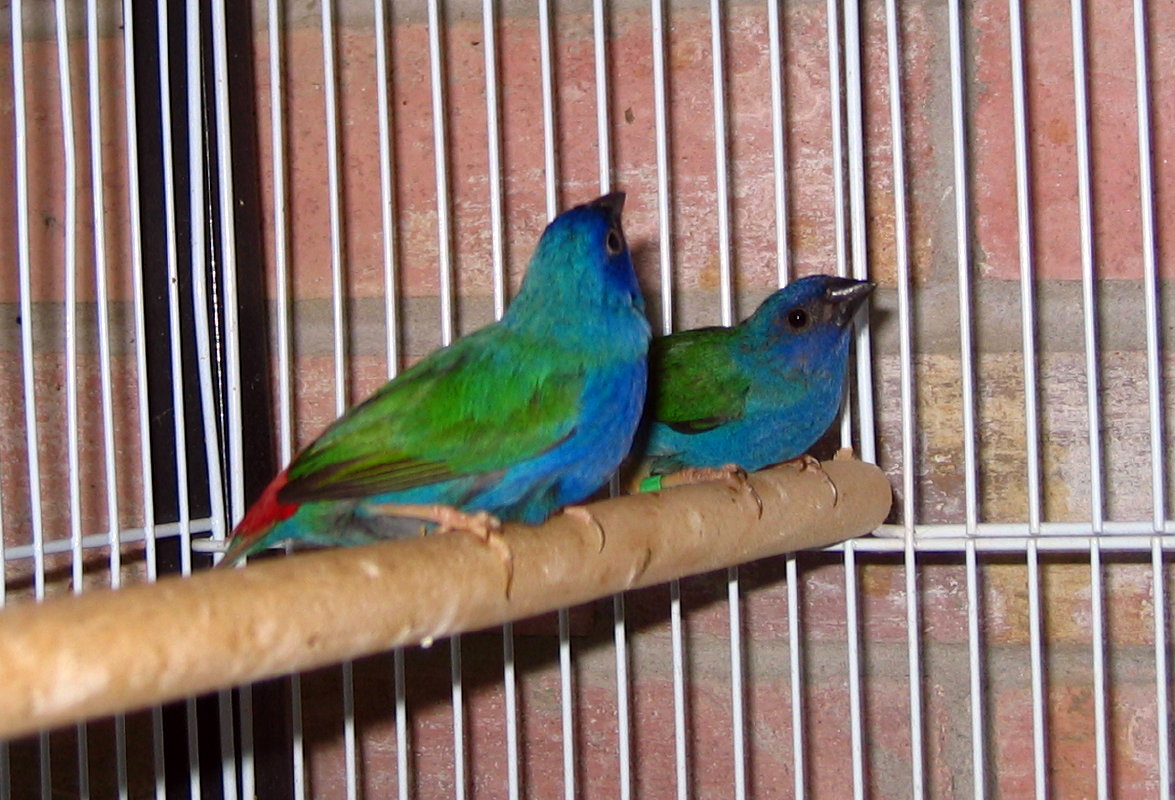
There are several species of parrot finches. Currently, I have red faced parrot finch, the sea green mutation of the red faced, forbes, and blue faced parrot finches. I've had better luck getting them to breed successfully in large flight cages than breeder cages, but if you have a steady calm pair, they may very well breed in a good size breeder cage.
Like most waxbills, they require a high protein supplement for successful breeding. Mine likes mealworms, but can be bred without live food as long as protein need is reached. Just one note of caution. These birds can easily become obese (due to their love of high protein foods), which will affect fertility and overall health. Keeping them in large flights and minimize rich foods during non-breeding season helps to keep them fit and trim.
Links for parrot finches:
1. http://www.finchinfo.com/birds/finches/species/red_throated_parrot_finch.php
2. http://www.hofmann-photography.de/html/forbes_parrotfinch.html
3. http://users.skynet.be/fa398872/navfram.en.htm
4. http://www.avianweb.com/parrotfinches.html
5. http://www.theparrotfinches.com/
6. http://www.parrot-finches.com/
*********************************************************************************************************************
Purple grenadier:


These are a beautiful species from Africa. They are slightly larger than gouldian and can be territorial during breeding, so a large flight is needed. The male can get very aggressive during breeding season, so if using a 30" breeding cage, a divider may be needed to prevent injury to the hen. I prefer to keep them in large flights, and breed individual pairs in 30"x18"x36" size cage at least. Cover with fake plants help to provide privacy as well as hiding place for the hen.
As with most waxbills, they require very high protein intake for successful breeding. Insect food is helpful. Live food helps to stimulate breeding behavior, although I'm hoping to eventually be able to breed them without live food.
So far, I've found my breeding pair to be very tight sitters, but for their first clutch, they kept sitting and didn't feed. Hopefully more experience will help them to be better parents.
Links for purple grenadiers:
1. http://www.honoluluzoo.org/purple_grenadier.htm
2. http://www.birdcare.com.au/purple_grenadier_waxbill.htm
3. http://www.nfss.org/articles/article/purlgren.html
*********************************************************************************************************************
Shaft tails:
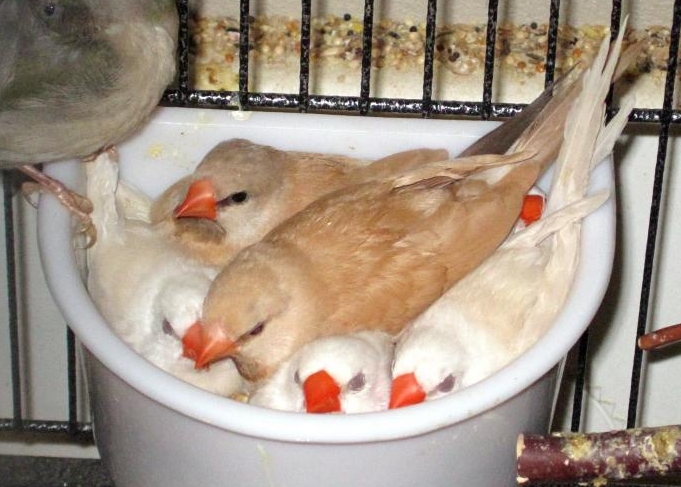
Also know as long-tail or Heck's, this is a charming and active finch from Australia. These birds can be a bit pushy, so best to mix with other active and pushy birds. I've kept 1-2 pairs in large flights with more laid back finches like gouldians without problems. The pair bond can be strong, so if there are particular birds you want to pair together, it's best to keep the pair by themselves starting at a young age so they will form the pair bond. Otherwise, I've put a group together and just observe to see who bonded with who so I can keep the pair together during breeding.
Sexing these birds can be difficult. Males tend to have a larger bib, longer tail, and sing. For some reason, out of all the finches I usually keep, sexing these birds has been the most difficult for me.
Several mutations exist: fawn, isabel, creamino, albino. My personal favorite mutations beside the normals is the isabel and creamino.
They do like to sleep in some sort of nest, but this is not necessary.
Breeding requires standard increased protein with egg food. They are not picky eaters. Some birds may have a tendency to kill their newly hatched babies - mostly the males I think, but other pairs can be very good parents even first time parents.
Shaft tail links:
1. http://www.finchinfo.com/birds/finches/species/shaft-tail_long-tailed_grassfinch.php
2. http://www.efinch.com/species/shaft.htm
3. http://www.singing-wings-aviary.com/shafttail.htm
*********************************************************************************************************************
Blue capped cordon blue:

A beautiful little finch from Africa. I love this species and started keeping them shortly after I started keeping finches, but are still being frustrated by their breeding behavior. Large aviary flight breeding will probably be more likely to lead to success than cage breeding, but more importantly is the food. Like other waxbills, they require high protein content. Getting parent raised birds will be more likely to lead to more parent raised babies. Getting birds that were not raised on live food will also be helpful. I try to increase the protein content in their egg food by adding a very high protein powder mix, insect powder mix, as well as freeze dried blood worms. These guys can be picky eaters. I'm still giving my current pair some mealworms to encourage breeding behavior, but is hoping to eventually phase out the live food.
These are a gentle species toward other species, and should not be mixed with other cordon blues as hybrids can occur. Also need to be separated from purple grenadiers because they will be attacked. Pairs should be kept separate from each other since other birds of the same species will not be tolerated and can be killed.
Cordon blue links:
1. http://www.finchinfo.com/birds/finches/species/cordon_bleu_waxbill.php
2. http://www.avianweb.com/cordonbleufinches.html
3. http://uniquebeak.homestead.com/UniqueBlue.html
*********************************************************************************************************************

Owl (bicheno) finch:
An adorable active little finch from Australia. They have a very sweet face and disposition that's easy to fall in love with. They are smaller than gouldians, but because of how active they are, larger flight cages should be used when not breeding.
Pairs will cuddle together at night. When given the right environment, they can be great parents and are very prolific. They love egg food and dried blood worms. When feeding babies, they require a lot of these high protein foods.
The only mutation I know of is the fawn, which is sex-linked recessive.
Telling the gender of these birds can be a bit of a challenge. The males tend to have a wider chest black band, whiter cleaner face and chest color, and a shorter stubbier beak than the hen. Of course only the male sings.
Owl links:
1. http://www.finchinfo.com/birds/finches/species/owl_finch.php
2. http://www.singing-wings-aviary.com/owlfinch.htm
3. http://www.efinch.com/species/owl.htm
4. http://www.avianweb.com/owlfinches.html
*********************************************************************************************************************
Society finch:

I find them to be very pleasant to keep. Their cuddly nature and variety of mutations make them very attractive for a communal aviary. They are willing breeders and will use anything as a nesting vessel.
Hardest part of keeping these birds is to tell the gender. Males sing. If a bird doesn't sing, it's a hen for sure only when it lays eggs.
Many mutations exist. The most commonly seen are the mottled pieds (chocolate, chestnut, fawn). The selfs are lovely (chocolate, chestnut, fawn). Euros have very nice belly scaling and are derived from hybridizing societies with mannikins. The grey mutation can exist in all colors. Creamino, marked pied, dilutes, albinos, pearls, and the list goes on.
They can be very good fosters for other species as well.
Society Finch link:
1. http://www.finchinfo.com/birds/finches/species/society_finch.php
2. http://www.efinch.com/species/society.htm
3. http://www.zebrafinch.com/SocietyFinch/Society.html
4. http://www.singing-wings-aviary.com/societyfinches.htm
*********************************************************************************************************************
Scarlet chested (Splendid) grasskeet:
One of the most beautiful parakeets. They are quiet and friendly. I safely keep them with my finches. Scarlets can breed in breeder cages or flights, but during nonbreeding season should be kept in large flights for exercise. They are not the most hardy of the parakeets, so should be kept out of damp, cold, and draft. Only males have the red chest.
Scarlets breeds easily and are in general good parents when given the right conditions. Egg food, veggies, and sprouted seeds are appreciated. Lovebird size breeder boxes are needed and wood chips and shavings are used as nesting material.
Several mutations exist: parblue (turquoise and pastel), white fronted blue, lutino, creamino (ino and parblue), albino (ino and white fronted blue), grey, cinnamon, pallid, violet...all are beautiful. They can also develop larger areas of red front, which is more of a modification than mutation.
Scarlet links:
1. http://www.avianweb.com/scarletchestedparakeets.html
2. http://www.grassparakeets.talktalk.net/
3. http://grassparrots.free.fr/scarletchest/scarletmenu.htm
4. http://www.grassparakeet.com/scarlet.htm
*********************************************************************************************************************
Turquoisine grasskeet:
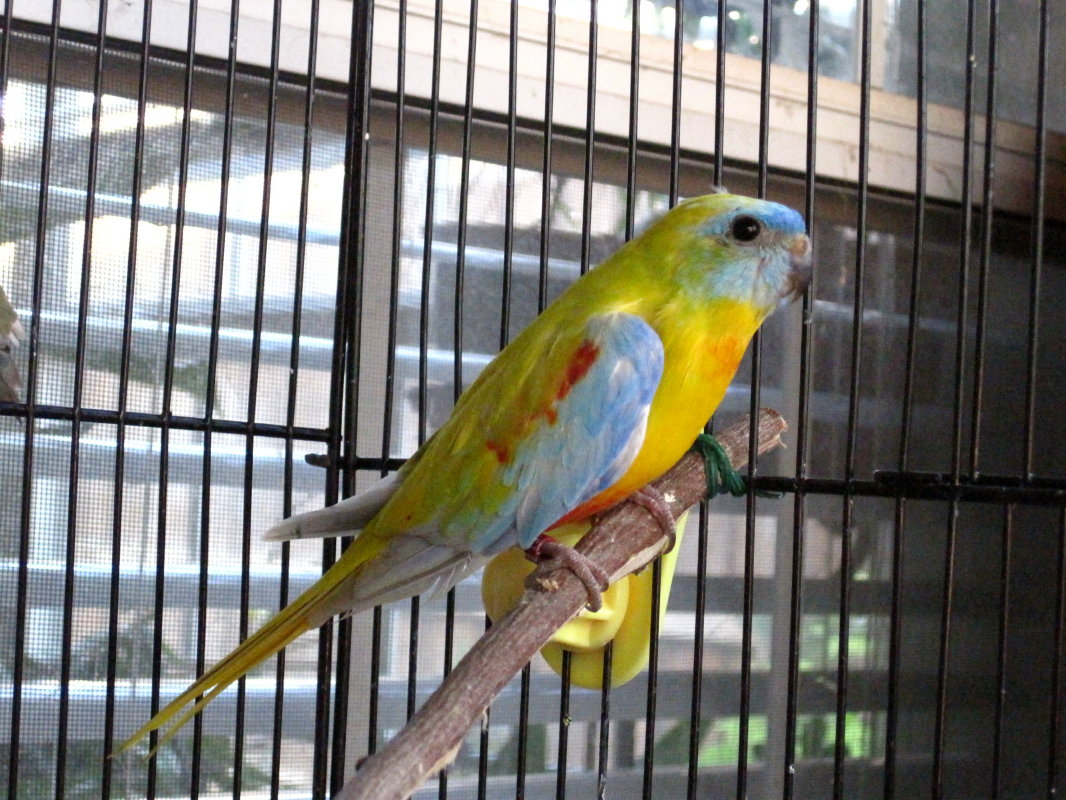
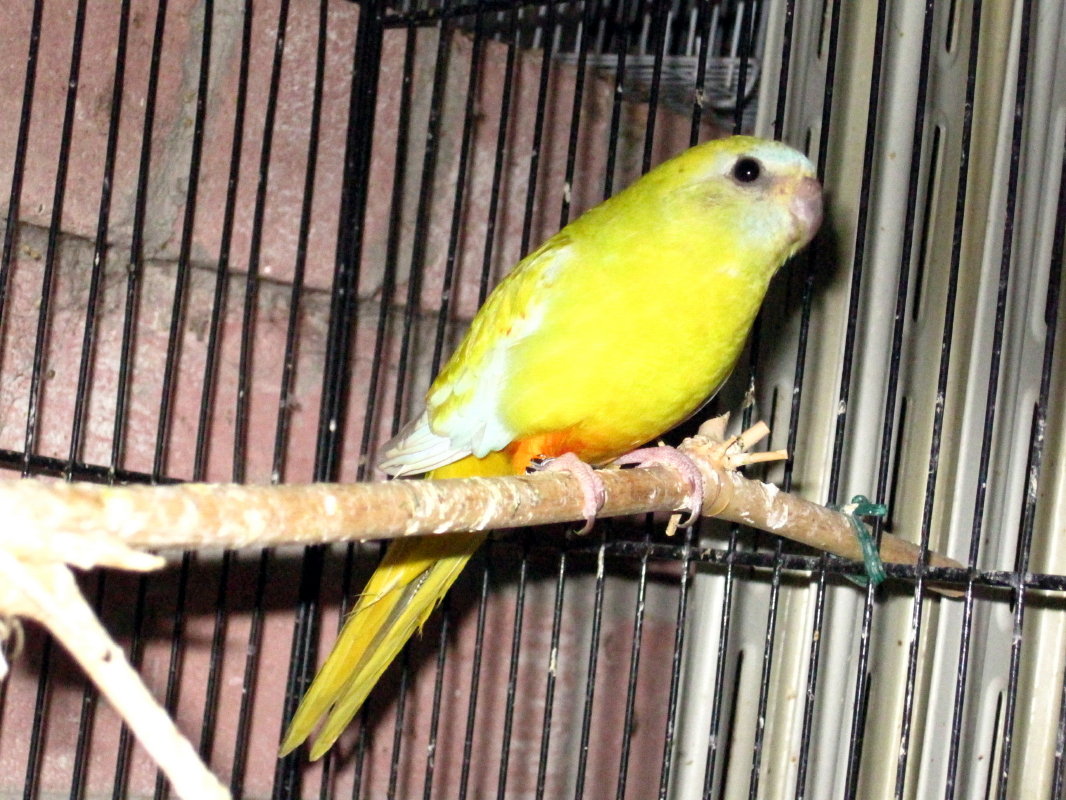
Their other requirements are similar to scarlets. Pairs can fight with each other around breeding season as well, but will settle down when eggs are laid. Only males have the red wing bar, although this may be differently in opalines.
Many beautiful mutations exist, most commonly seen are the full red front (more of a modification), yellow, and opaline.
Turquoisine links:
1. http://grassparrots.free.fr/turquoise/menuturqgb.htm
2. http://www.avianweb.com/turquoisineparrot.html
3. http://www.grassparakeet.com/turquois.htm
4. http://australian-animals.net/turq.htm
*********************************************************************************************************************
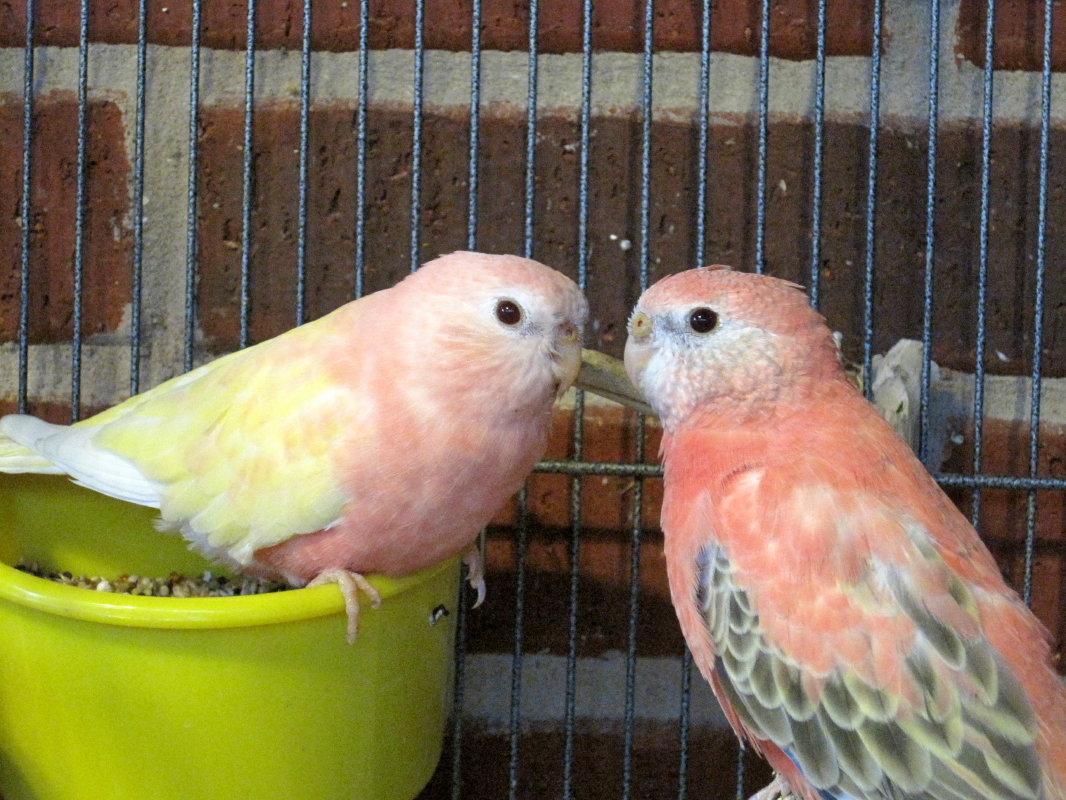
Bourke grasskeet:
Where else can you find a pink colored sweet quiet parakeet that singings beautifully too. They are a little bigger in size than scarlets and turquoisine, but are very peaceful and can be kepted with any friendly finches or grasskeets.They are hardy and require similar care as other grasskeets.
Mutations include the opaline (which most commonly is the rosey, but can be rainbow, blue, green, yellow as well), lutino, rubino (opaline and ino), cinnamon, fallow (several different kinds), and one of my favorites being the white faced pink (opaline and fallow).
Bourke links:
1. http://www.grassparakeet.com/bourke.htm
2. http://grassparrots.free.fr/bourkes%27p/bourkpmenu.htm
3. http://www.avianweb.com/burkesparrots.html
4. http://www.bourkes-parakeet.nl/pg/E-version.html
5. http://www.singing-wings-aviary.com/Bourke%20Parakeet.htm